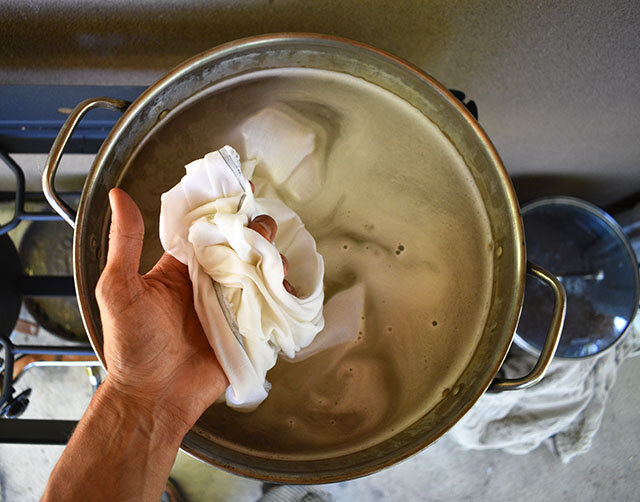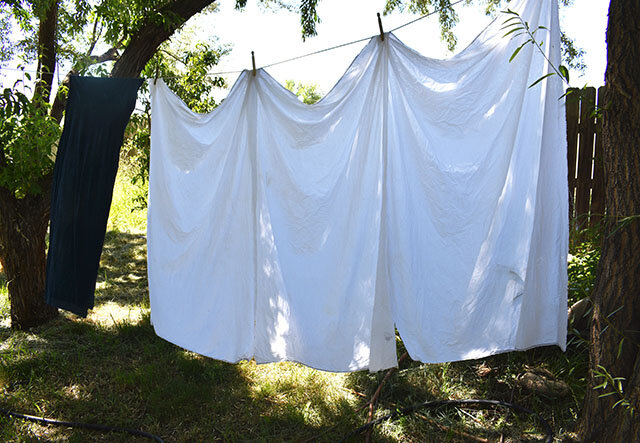Natural Dye Series Post 1: Scouring
There are many steps in the natural dye process, some of which are more exciting than others yet all equally important. The first step is scouring which falls into the not so fun category but good scouring is essential. This post explains how to scour cellulose based fabrics such as cotton, hemp, and linen. Cellulose fibers contain waxes and pectins which must be removed prior to dyeing to facilitate a good dye to fiber bond. Proper scouring provides the most even and colorfast results. If you’re working with PFD (prepared for dye), or RFD (ready for dye) fabrics scouring is likely not necessary, but I do recommend washing them in the washing machine on a regular cycle. Before I explain the scouring process let’s talk fabrics.
I mainly work with GOTS certified organic cotton, organic linen, hemp, and hemp/ organic cotton blends which I order from various sources. I encourage you to order samples before committing to purchasing yards of fabric so you can see and feel the different textures and weaves to determine which most inspire you. For quilting I typically work with fabrics that are in the range of 4.5-6 ounces per square yard. Tighter weaves like percale and sateen are more difficult to dye. High quality muslin is a better option.
scouring SUPPLIES
washing soda
synthrapol
large pot
large wooden spoon
cellulose fabric
Washing soda is also known as soda ash and sodium carbonate. Synthrapol is a mild PH neutral detergent and is great for scouring, and washing naturally dyed fabrics and quilts. Any mild natural liquid laundry detergent is fine to use for scouring. Both washing soda and synthrapol can be purchased from natural dye suppliers. You’ll need a large pot for scouring and it’s absolutely important with ALL the natural dye processes that your dye pots and tools are separate from your kitchen pots and tools.
PROCESS
Fill your large pot with water and heat it up on the stove. These instructions are for around 1 pound of fabric. If you have a scale the ratio is 2 tsp. detergent and 8 tsp. washing soda per pound of fabric (or somewhere near that, it really doesn’t have to be exact!) If you do not have a scale use the amounts of detergent and washing soda to scour about 2 yards of fabric. That should be about right I think. When the water is pretty warm add the detergent and washing soda and give it a stir. Add the fabric and continue heating the water. Bring to a gentle boil and let it simmer for about an hour. The water will quickly turn brown as the waxes and pectins are released. After scouring let the water cool until it’s not dangerously hot and then dump the dirty water out and fill your pot with clean water to rinse your fabric. Cold water is fine for rinsing. Hang to dry.
Adding the fabric to the pot for scouring.
The water after scouring is brown from all the pectin and waxes that were released.
Scoured fabric drying on the line.
So that’s the first step. Boring but necessary! In the next post I will explain how to mordant. Below I have listed the things you will need to order and have on hand for part 2.
SUPPLY LIST FOR PART 2
tannin
aluminum potassium sulfate
Washing Soda
*iron (optional)
I recommend purchasing from a dye supply store like Maiwa, Botanical Colors, or Dharma Trading because you can find all these things in one place. There are many different tannins to choose from. If you’re wanting to achieve dark colors choose a darker tannin such as chestnut, cutch or walnut. For lighter colors choose clear or yellow tannins like galls or myrobalan. Having a variety of tannins on hand is invaluable.
Iron (ferrous sulfate) can be used as a modifier to “sadden” dye colors. This is not required but provides an ability to create a broader range of colors.
If you have any questions please leave them in the comment section below. Happy scouring!




